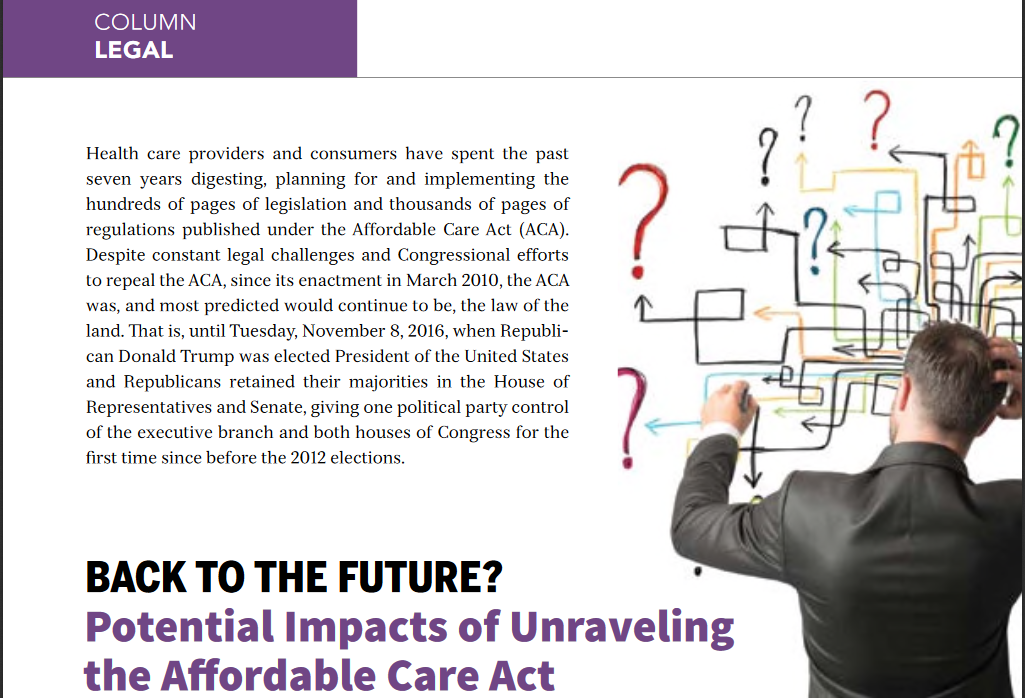Seiter Discusses Impacts of Trump on Health Care Providers, Consumers, Third-Party Payers
March 09, 2017
Article Featured in Health Care Journal of Baton Rouge
"Back to the Future? Potential Impacts of Unraveling the Affordable Care Act"
By Patrick D. Seiter
Taylor Porter Partner; Health Care Practice Group Leader
patrick.seiter@taylorporter.com
 Health care providers, third-party payers and consumers have spent the past seven years digesting, planning for and implementing the hundreds of pages of legislation and thousands of pages of regulations published under the Affordable Care Act (ACA). Despite constant legal challenges and Congressional efforts to repeal the ACA, since its enactment in March, 2010, the ACA was, and most predicted would continue to be, the law of the land. That is, until Tuesday, November 8, 2016, when Republican Donald Trump was elected President of the United States and Republicans retained their majorities in the House of Representatives and Senate, giving one political party control of the executive branch and both houses of Congress for the first time since before the 2012 elections. Post-election, President Trump has continued pursuing his campaign promise to repeal and replace the ACA, though few specifics have emerged regarding the President’s replacement plan except that, as President Trump was quoted in the Washington Post, it will offer “insurance for everybody” and be “much less expensive and much better.”
Health care providers, third-party payers and consumers have spent the past seven years digesting, planning for and implementing the hundreds of pages of legislation and thousands of pages of regulations published under the Affordable Care Act (ACA). Despite constant legal challenges and Congressional efforts to repeal the ACA, since its enactment in March, 2010, the ACA was, and most predicted would continue to be, the law of the land. That is, until Tuesday, November 8, 2016, when Republican Donald Trump was elected President of the United States and Republicans retained their majorities in the House of Representatives and Senate, giving one political party control of the executive branch and both houses of Congress for the first time since before the 2012 elections. Post-election, President Trump has continued pursuing his campaign promise to repeal and replace the ACA, though few specifics have emerged regarding the President’s replacement plan except that, as President Trump was quoted in the Washington Post, it will offer “insurance for everybody” and be “much less expensive and much better.”
Among the concepts or strategies suggested as alternatives to the ACA are tax credits for consumers who purchase health insurance, increased emphasis on Health Savings Accounts (HSAs), “high risk pools” to cover individuals with expensive, chronic illnesses, and Medicaid block grants. Regardless of the plan ultimately crafted to replace the ACA, however, no doubt virtually every provision of the current law will be in play. This article highlights just a few of the many direct and major impacts that could be felt by health care providers, third-party payers and consumers if key provisions of the ACA are eliminated or significantly altered by new legislation.
For Health Care Providers:
· Decreased Medicaid Reimbursement. A cornerstone of the ACA, expanding Medicaid eligibility to all individuals under age 65 up to 138% of the Federal Poverty Level resulted in millions of previously uninsured Americans, including approximately 350,000 in Louisiana, becoming eligible for Medicaid coverage. This resulted in both increased volumes for providers due to pent-up demand for services from the previously uninsured, as well as a payment source for care provided that was previously uncompensated. The American Hospital Association estimates that hospitals alone could lose more than $160 billion as a result of the decrease in Medicaid revenue and the increase in unpaid medical bills if Medicaid expansion is repealed and the expansion population loses coverage. Further, replacing the current federal financial participation (FFP) model for Medicaid funding, under which an increase in state funding for Medicaid results in a corresponding increase in federal funding, with a block grant model, under which the federal contribution to a state’s Medicaid program would be capped, would almost assuredly result in reductions to state Medicaid budgets, particularly in states such as Louisiana with high FFP rates. A reduction in Louisiana’s total Medicaid budget would undoubtedly be felt most acutely by Louisiana’s health care providers.
· Increased Uncompensated Care. As a corollary to the decreased revenue providers will experience if people who gained coverage under the ACA lose that coverage, if the ranks of the uninsured return to pre-ACA levels, so will the levels of uncompensated care.
· Increased Cost-Sharing and Bad Debt. While no clear replacement plan for the ACA has yet emerged, virtually every plan or proposal currently under consideration promotes expanded use of HSAs. The theory behind HSAs, when coupled with high-deductible insurance plans, is that health care consumers will be more judicious in their use of health care services and products when they are responsible for paying a substantial portion of the cost out of an HSA, thereby promoting competition among providers based on cost and quality, as well as lowering premium costs. Shifting payment responsibilities from third-party payers to consumers, however, has the additional effect of increasing providers’ collection burdens and bad debt for unpaid medical bills. Not every employer will fund HSAs for its employees, and not every employee is in a position to fund an HSA for himself or herself. Therefore, the funds needed to pay a high deductible may not be readily available when necessary. Further, even if the patient has funds available, collecting payments from an individual is more difficult than collecting on claims submitted to third-party payers. While it is relatively easy and common for providers to require patients to pay a modest co-pay or co-insurance up front, it is more difficult to enforce those policies when the upfront payment is $1,500, or higher.
· Reimbursement Reforms. Frequently lost in the intense political rhetoric is the fact that ACA provisions designed to reduce costs and improve quality have fueled much of the movement from volume-based to value-based reimbursement. Alternative payment models such as accountable care organizations and episode-based payments have resulted from the ACA through CMS’s Center for Medicare and Medicaid Innovation (CMMI). The CMMI has been a frequent target of Congressional Republicans, and its elimination, or restrictions on its authority or budget, could have a significant impact on the future direction of health care reimbursement.
For Third-Party Payers:
· Guaranteed Issue and Community Rating. Another cornerstone of the ACA are the “guaranteed issue” and “community rating” requirements applicable to insurers in the individual market. Guaranteed issue is the requirement that health insurers issue a policy to any eligible applicant in the individual market, regardless of health status. Community rating is the requirement that rates are set based on the health status of the community, not on the health status of the individual purchasing insurance. These requirements are designed to assure that all individuals in a given market have the same opportunity to purchase health insurance, and cannot be denied coverage or charged a higher premium by an insurer because they are already sick or pose a higher risk of becoming sick. If these ACA provisions are repealed, we could see a return, as some are currently advocating, to “high risk pool” health plans. These high risk pools, such as Louisiana Health Plan, which existed prior to the ACA, attracted the sickest, and therefore highest cost, members, and typically offered annual and lifetime benefits far below the members’ needs, at premiums far above those available to healthy people in the individual market. The concept of “pooling” the sickest, highest cost individuals into a narrow group for health insurance purposes is directly contrary to the ACA’s goal of spreading insurance risk across a broad range of people, including the young and healthy, but could stage a comeback post-ACA.
· Employer Mandates. Some of the most legally complex and highly-criticized provisions of the ACA are those requiring employers with more than 50 employees to provide health benefits to at least 95% of their full-time employees and dependents to age 26, or pay a penalty. Despite concerns that the ACA would disrupt the employment-based system through which most Americans receive health care coverage, this sector has remained fairly steady, with costs increasing at only fraction of those experienced by individuals obtaining coverage through the ACA health insurance exchanges. Nevertheless, government-imposed mandates are anathema to most Republicans, so chances are high that these provisions will be repealed. At the same time, some current Republican proposals float the concept of limiting the deductibility of all employer-provided health benefits to replace taxes on health insurers, medical device makers and the so-called “Cadillac tax” on rich benefit plans as a means to finance the expanded coverage achieved by the ACA. If passed, such a dramatic change could prove more disruptive to the employment-based system than the ACA mandates.
· Essential Health Benefits. Also among the most highly-criticized provisions of the ACA are the requirements that health benefit plans and insurance policies provide at least a minimum level of benefits. These provisions backfired on President Obama when he promised that consumers could retain their existing coverage if they liked it, which turned out to not be true if the existing coverage did not satisfy the essential health benefits requirements. As a result, individuals with limited benefit plans had to switch to plans with higher benefit levels – and incur the higher costs associated with higher benefits. The flip-side, of course, is that limited benefit plans, while more affordable when people are healthy, frequently do not provide sufficient coverage when they are not, leaving them personally exposed and vulnerable to large medical bills. Nevertheless, virtually all agree that the biggest problem presented by the ACA is the dramatic increases in the cost of health care coverage to individuals who obtain it through the health care exchanges. The simplest and most direct route to reducing the cost of health care coverage is reducing the level of health benefits provided. Eliminating the requirement that health plans offer essential health benefits – and the return of limited benefit plans – is likely to be part of Republican efforts to repeal and replace the ACA.
· Annual and Lifetime Maximums. Prior to the ACA, health plans and insurance policies frequently imposed maximum limits on the amount it would pay in benefits for a covered individual during the year and during that individual’s lifetime. Further, absent state laws requiring guaranteed issue and community rating, individuals who reached their maximum benefits became uninsurable. The ACA did away with annual and lifetime maximums for essential health benefits. Most experts agree that the incremental cost to third-party payers (and therefore the cost to employers and individuals) of eliminating annual and lifetime maximums is quite modest. Nevertheless, the notion that health insurers and benefit plan sponsors should be free of mandates and have maximum flexibility in structuring benefits as a means of controlling costs has political appeal, so annual and lifetime maximums could easily return to the health benefits landscape.
For Health Care Consumers:
· Loss of Coverage. Without a doubt, the biggest threat to consumers posed by repealing the ACA is the loss of coverage facing individuals who gained it, either through Medicaid expansion or subsidies provided to purchasers on the health insurance exchanges, under the ACA. The Congressional Budget Office (CBO) estimates that approximately 18 million people would lose coverage and premiums would rise as much as 25% for individual purchasers in the first year alone, and the number of individuals losing coverage would rise to 32 million by 2026, if the ACA is repealed without replacement. Medicaid expansion and health insurance subsidies are the primary reasons for the significant reduction in the number of uninsured Americans since those provisions of the ACA have been implemented. While House Speaker dismissed the CBO Report as “meaningless” because it does not take into account a replacement plan, the challenge for President Trump and Republican leadership is to come up with alternatives to Medicaid expansion and health insurance subsidies that would continue to provide lower-income Americans with access to affordable health care coverage and avoid having the number of uninsured Americans return to pre-ACA levels.
· Coverage of Pre-existing Conditions. Laws chipping away at an employer’s or insurance company’s ability to limit or exclude coverage of pre-existing medical conditions have been around since HIPAA was passed in 1996, and the ACA virtually eliminated that ability beginning in 2014. While a full repeal of the ACA would restore some of the pre-ACA “loopholes” that sometimes resulted in the exclusion or limitations on coverage of pre-existing conditions, eliminating those loopholes has proven popular with the public and been embraced by the Republican majority, so those provisions will likely not be repealed or, if repealed, will also be included in replacement legislation.
· Dependent Coverage to Age 26. Requiring health plans and insurance policies to offer dependent coverage to age 26 is another feature of the ACA that has proven popular with the public. Again, therefore, those provisions will likely not be repealed or, if repealed, will also be included in replacement legislation.
· Individual Mandate. Urged by health insurers, the goal of the individual mandate is to spread the insurance risk across as wide a group of people as possible, including the young and healthy who might not otherwise feel the need to have health insurance, by requiring all people to have health insurance, or a pay a tax penalty. Not surprisingly, the individual mandate has been heavily criticized by Republican lawmakers, and is likely to be repealed. The failure to require people to buy health insurance, however, will undoubtedly result in a sicker, higher cost insured pool, especially if guaranteed issue remains the law, which some insurers have said will cause them to exit the market, or at least raise premiums even more. Repealing the individual mandate will no doubt be politically popular, but could have consequences in the insurance market that are not so popular.
With all its pros and cons, complexity and unintended consequences, the ACA is a reflection of how difficult it is to establish policies that simultaneously addresses health care access, cost and quality. These policy decisions are extremely difficult – yet extremely important – and the hyper-politicalization of the process only makes it more difficult to achieve. Clearly, the ACA has not been 100% successful delivering on its promises to improve access while controlling costs and improving quality. Neither, however, has it been the “disaster” characterized by candidate and now President Trump. Indeed, moderate Republicans have begun advocating the need to “repair,” rather than “repeal and replace,” the ACA. As they continue to delve into the issues, the President and Congress are likely to discover, to the extent they haven’t already, that “repairing” the ACA is perhaps the only feasible route to fulfilling the President’s promise of a plan that will offer “insurance for everybody” and be “much less expensive and much better.”
About Patrick D. Seiter: Patrick D. Seiter is the Taylor Porter Health Care Practice Group Leader. Practicing law since 1985, Pat represents and advises health care clients in a wide range of business, transactional and regulatory matters, including business organizations and contracts, mergers and acquisitions, joint ventures, managed care and provider network contracts, fraud and abuse, Stark, health information technology, HIPAA, EMTALA, medical staff, Medicare and Medicaid reimbursement, federal and state regulatory compliance, and alternative delivery and payment systems. Pat has been selected for inclusion in Chambers USA and The Best Lawyers in America®, and was named "Lawyer of the Year" for Health Care Law in Baton Rouge, in both 2013 and 2016.
Read our Case Studies
See how we can help. Contact us today
- Disclaimer
- © Taylor, Porter, Brooks & Phillips L.L.P. All rights reserved.




